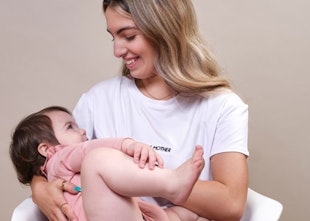Breastmilk is a live substance that contains cells which can kill germs and help fight infection.
It is important for your baby's healthy growth and development to keep breastmilk safe for your baby.
We all know fresh breastmilk is best for our baby or toddler but what if you're heading back to work after maternity leave or need to be away from your child for a night or two?
Follow this guide to find out how to store, freeze and thaw breastmilk safely for full-term healthy babies. Milk storage guidelines differ for premature or hospitalized babies as they are at more risk of infection - please discuss these guidelines with your health care provider.
What should I store my breastmilk in?
BPA-free hard plastic and glass containers with leak-proof lids are the preferred storage container as they lose fewer milk fats and antibacterial cells.
However, they are a little awkward to store and they take up more space in the freezer. Single-use breastmilk freezer bags are also an option but tend to be a bit more awkward when pouring to and from the bag.
No matter how you choose to store your breastmilk, always leave some room at the top of the bag or container to allow for expansion - just like water, human milk expands when frozen. It advised to leave at least an inch.
Always squeeze out any air when using storage bags and make sure they're sealed properly so they don't leak, some people tend to double bag plastic storage bags to prevent this from happening. When using storage pots it is recommended not to tighten the lids until the breastmilk is completely frozen.
It is important you label each container or storage bag clearly with the date you pumped your milk so you know which milk needs to be used first. The oldest milk should be used first.

How long can you store breast milk?
Fresh breastmilk can be stored at the back of the fridge away from the door for up to eight days while thawed milk from the freezer must be used within 24 hours.
Frozen milk, on the other hand, can be stored in a fridge freezer for up to 6 months or up to 12 months in a deep freezer although it is best to use the milk within 6 months.
In a bid to minimise any waste, try to store breastmilk in small amounts. Storing in smaller amounts also means quicker defrosting and warming time.
You can store breastmilk from different pumping sessions in one container - just use the date the milk was first expressed, however, make sure the new milk has cooled down before combining the two.
Frozen breastmilk should ideally be thawed in the fridge and can be stored there for up to 24 hours. It is advised never to refreeze breastmilk once thawed.
Other things to know about storing breastmilk:
The colour of your breastmilk may vary in colour depending on your diet. It might even taste different or have a different consistency than freshly expressed milk but it is still safe for your baby to consume.
Your hands need to be cleaned before each pumping session although it is not necessary to wash your breasts - your usual daily shower is enough. All other pumping equipment needs to be sterilized following the manufacturer's instructions






